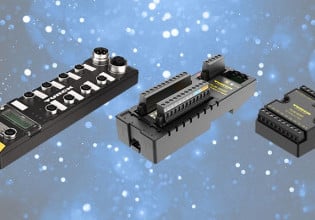The Main Difference Between IoT and IIoT
Learn about the difference between IoT and IIoT and how to integrate them into a specific system based on the needs of your application and facility.
IoT and IIoT are two terms that are used interchangeably. They stand for the Internet of Things (IoT) and the Industrial Internet of Things (IIoT). Before understanding the difference between these two concepts, it is best to know the superset of both IoT and IIoT connected devices.
Connected Devices
Any device that connects to a network to send and receive information is called a connected device. IoT and IIoT are subsets of connected devices. An example of connected devices that is not IoT will make the definition of the superset connected devices more clear.
One example of a connected device that is not IoT is an air conditioning system controlled by a mobile application when connected to the same WiFi network. Here, the transfer of information happens within the local network.

Figure 1. Siemens Industrial IoT Gateways SIMATIC CloudConnect 7. Image used courtesy of Siemens
No information is sent over the internet to remote servers. The air conditioning system is a connected device but not considered IoT. If the air conditioning can be controlled through a mobile application from the office over the mobile data network, it becomes IoT. For the instruction from the smartphone to reach the device, it has to traverse through the internet. Most of the time, a remote server routes the data.
What is the Difference Between IoT and IIoT?
Any device that can connect to the internet and transfer data to a remote data server is termed the Internet of Things (IoT). When IoT devices are used only for industrial purposes, they are termed as Industrial Internet of Things (IIoT). Just like IoT is a subset of connected devices, IIoT is the subset of IoT. All IIoT devices are IoT devices, but all IoT devices are not IIoT devices.
History of IoT
IoT as a concept has been in the scientific research arena since the 1970s, specifically in the development of automation technologies with PLC and SCADA systems. DARPA created ARPANET, the precursor on the internet we know today, in 1969. The combinations of these two ideas played within the minds of scientists for quite a while.
The conceptual talks in the 1970s were called ‘pervasive computing’ or ‘embedded internet. The term Internet of Things was coined by Kevin Ashton, an engineer for P&G developing RFID technology for supply chain innovation. IIoT was thought of and termed separately much later to refer specifically to industrial use cases of IoT.
Differences in IoT and IIoT
Some of the key differences that distinguish IoT and IIoT are described below.
Applications
The names of the different technology reveal the nature of applications they will be used for. IIoT is a device that has been widely used in industrial applications in manufacturing and industries like mining, oil & gas, transportation, etc. IoT is the superset of IIoT. But in colloquial references, IoT stands for the consumer application of IoT. When refrigerators, air conditioning, microwave ovens, etc., connect to the cloud, they are referred to as IoT.
Risk and Security
IIoT devices can be used in critical infrastructure like power plants, sewage treatment plants, etc. Compromising such devices can cause large-scale trouble for a nation. We saw the impact disruption of a single pipeline can do.

Figure 2. IIoT Telematic Data Collector gateway system. Image used courtesy of SICK AG
Thus IIoT devices have higher chances of experiencing an attack from malicious actors. Therefore cybersecurity concerns are very real for them. IIoT devices need much more efficient and robust security.
Compared to IIoT, IoT devices face lower security risks. They are mostly in consumer devices. An attack on them would be a nuisance but not a catastrophe like when critical infrastructure breaks down. A synchronized attack on all the devices from an OEM can cause much more damage, but the chances of that are quite slim. Security requirements are much for relaxed compared to IIoT devices.
Scale
The scale of both IoT and IIoT will vary. A company can have only a single factory, and it uses IIoT; therefore, the scale is small. Another company might have hundreds of facilities and use IIoT devices across the entire supply chain, including its vendors, suppliers, and customers.
Similarly, IoT devices can be used by only a handful of consumers or millions of consumers who buy from the same brand. In most instances, IIoT has a much larger scale than IoT devices. This is because IIoT has much more applications today. Once IoT devices pick up steam among consumers, they will be massive compared to the entire IIoT segment.
Reliability
IIoT devices have to be much more reliable than IoT devices. As mentioned earlier, critical infrastructure will be using IIoT and would need to be much more reliable. The dangers that a faulty device can cause are much larger in industrial applications.
IIoT devices also need to last for a longer period. Manufacturing plants and equipment are built with larger time horizons in mind, and the devices need to function reliably for a longer timer than typical consumer IoT applications.
IIoT in Process Automation
Process automation already uses sensors to function. Those are critical in an IIoT infrastructure. It will also have a network in place for communication. Cloud computing, fast storage, and software application are the additional components needed for IIoT implementation.

Figure 3. A cement plant where IIoT and process automation are commonly used. Image used courtesy of ABB
The benefit of having an IIoT infrastructure is that it can be designed so that machines communicate with each other without the need for a central server. It is called M2M or machine-to-machine communication.
Using IIoT brings some benefits to process automation. Some of them are:
- Machine learning algorithms can improve process efficiency.
- Preventive maintenance can be done with the help of continuous historical data.
- Digital twin technology can be easily implemented. This will help in preventive maintenance and easier troubleshooting in the event of machine failure.
How to Integrate IIoT to Existing System
Implementation of IIoT in an existing plant has to be well thought out with adequate planning. You don’t need to integrate the complete infrastructure in one go. But before implementation, you need to plan how various machines and subsystems of a facility will function after IIoT implementation. After that, it can be implemented in one subsystem after another.
Machines and their parts will need maintenance and replacement regularly. The best path moving forward may be to replace existing machines with IIoT enable devices at the time of replacement. This will reduce the capital expenditure as the replacement will be at the regular replacement cycle and not a separate Capex cycle.

Figure 4. A graphic showing how IoT and IIoT devices connect to other components within a facility. Image used courtesy of Emerson
A few key things to keep in mind during implementation are listed below.
- Consider interoperability. Make sure all the devices bought at different times will be capable of operating smoothly with each other.
- Decide on the network, software platform, and other computing hardware before implementation. This will help in making the later decision for components simpler.
- Emphasize the device and plant security. Larger facilities are susceptible to cyberattacks. Preventive action is much better than reactive action.
- The same OEMs will have IIoT enabled devices. You can purchase those for easier integration.
- Purchasing from the same OEM will ensure all the devices are interoperable. But this can also lead to lock-in with the OEM, and they will have pricing power.
Business considerations must be kept of paramount importance while opting for an IIoT platform and other infrastructure components.
Both IoT and IIoT serve a purpose in connectivity and bringing digital transformation closer to a system or facility. It’s important to understand the differences between these two cutting-edge technologies so you can optimize your processes accordingly.






